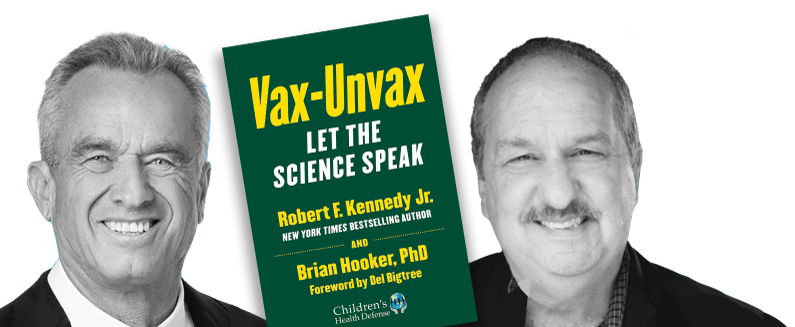‘Autism Tsunami’: Society’s Cost to Care for Expanding, Aging Autism Population Will Hit $5.54 Trillion by 2060
A 2021 study predicting a tsunami of future autism cases and costs if environmental root causes of the disease remain unaddressed was retracted last year under pressure from the “autism industry,” and republished last month. Rising prevalence rates and lack of state services show the predicted crisis is already playing out.
Miss a day, miss a lot. Subscribe to The Defender's Top News of the Day. It's free.
Editor’s note: This article originally appeared on Jan. 5. We are republishing it this week as part of The Defender’s coverage of Autism Acceptance Month, formerly known as Autism Awareness Month.
The societal costs of autism spectrum disorder (ASD) in the U.S. are projected to reach $589 billion per year by 2030, $1.36 trillion per year by 2040 and $5.54 trillion per year by 2060 if steps are not taken to prevent the disorder, according to a study published last month.
The paper, “Autism Tsunami: The Impact of Rising Prevalence on the Societal Cost of Autism in the United States,” was first published in 2021, in the Journal of Autism and Developmental Disorders (JADD). It was retracted almost two years later by the publisher and editor, citing “concerns” with methodology and the authors’ “non-financial interests.”
Last month, Science, Public Health Policy and the Law peer-reviewed and republished the study — the first to project present and future costs of ASD that links rising costs to the increasing prevalence of the disorder.
The authors found that previous studies, which didn’t account for increasing prevalence, tended to overestimate current costs — because they assumed prevalence rates among adults are the same as rates among children — and underestimate future costs associated with a growing autistic population with shifting care needs.
Researchers Mark Blaxill, Cynthia Nevison, Ph.D., and Toby Rogers, Ph.D., projected future ASD costs in three scenarios: a base case scenario assuming the continuation of existing trends; a low scenario providing a conservative estimate of future costs; and a prevention scenario exploring possibility of future mitigation of environmental causes.
But these two premises of the paper — that prevalence is increasing and that environmental intervention is possible — made a straightforward modeling paper controversial and were the basis of the “concerns” raised that led to its retraction.
Those premises ran counter to the deeply held assumptions of the autism research and treatment industry, which continues to sidestep the issue of increasing prevalence and holds that autism is primarily a genetic and not an environmental disease.
U.S. could surpass 6% rates of ASD in children in 2024, 7% in 2032
To build their model, the researchers estimated four key parameters: the historic and future prevalence of ASD, the future size of the ASD population, the cost per individual over the course of a lifetime, and inflation projections.
Prevalence projections were based on the California Department of Developmental Services caseload data from 1931 to 2016. The researchers used U.S. Census Bureau population predictions to translate prevalence into actual numbers of people with autism. They multiplied those by different cost categories partitioned by age group and severity of ASD and applied an inflation index to their projections.
Nevison told The Defender this approach to calculating future costs was built on previous models that similarly identified cost categories and multiplied them by autism populations in each age group.
“But we used a more sophisticated prevalence model, and that provided an advance over previous work,” she said.
Their ASD prevalence model showed that based on current trends, the U.S. could surpass 6% rates of ASD in children born in 2024 and 7% born in 2032, and then would likely rise more slowly after that. This differed from previous models, which predicted continuous exponential growth.
Costs associated with ASD included “non-medical services” like community care and day programs, individual and parent productivity losses, estimated special education costs, early and behavioral intervention and medical costs.
Rising prevalence itself makes costs go up, the study showed, but so does the fact that the mix of costs changes over time as the autism population ages and has different care needs.
As people age, their needs change, Blaxill told The Defender, “You’re dealing with education and parental loss productivity in the early years, and you’re dealing with residential services and medical care and lost adult productivity of disabled people. So it’s a whole different profile.”
As the first generation of parents of children of the autism epidemic, who shouldered much of the burden of care-taking, begin to die around 2040, according to the study, costs of care that had been borne by them will shift onto state and federal governments.
The cost increase, Blaxill said, “is radical, it will cost $5 trillion a year.”
Nevison told The Defender that for their “prevention” scenario they looked to an existing example with good data where ASD rates had gone down.
She and a colleague published that research in JADD in 2020, showing that while ASD rates, which had increased for all U.S. children across birth years 1993-2000, either plateaued or declined among white families living in wealthy counties, suggesting those families made changes that lowered their children’s risk of ASD.
“The Prevention scenario assumes that these parental strategies and opportunities already used by wealthy parents to lower their children’s risk of ASD can be identified and made available rapidly to lower-income children and ethnic minorities, who are currently experiencing the most rapid growth in ASD prevalence,” the “Autism Tsunami” authors wrote.
The paper does not indicate what those changes may have been, but Blaxill told The Defender they hypothesized the changes happened among families who followed alternative vaccination schedules and other lifestyle changes.
Even in the prevention scenario, the paper found, the cost of ASD will skyrocket to $3.7 ± 0.8 trillion annually by 2060 because it still needs to account for the demographic momentum of the large ASD population born over the last three decades.
The authors concluded that rising autism rates must be taken seriously as a public health and economic policy issue.
“Paradoxically, the future costs of autism loom so large that, rather than responding with a sense of urgency as one might expect, policymakers thus far have generally failed to engage with the policy implications at all,” the authors wrote.
“We hope this paper will serve as a wake-up call for the public health emergency that the societal cost of autism represents to the economic future of the U.S.”
A ‘digital scarlet letter for eternity’
After the paper “sailed through peer review” at JADD, and became one of the journal’s most downloaded papers, there was immediate pushback, particularly in articles posted on the Spectrum News website (now The Transmitter). Former JADD Editor-in-Chief Fred Volkmar launched an investigation into the study based on concerns raised.
One article on Spectrum even included a Twitter post that implied the authors’ idea of prevention was “eugenics,” an accusation the authors told The Defender was extremely shocking and hurtful and clearly an attempt to “cancel” them.
Rogers told The Defender, and detailed in a Substack post, that they had expected some negative response from gatekeepers, “because we broke new ground and the autism debate is always fraught in this country.”
But, he said, he and his co-authors were surprised when they were informed that Volkmar solicited new critical reviews and gave them one week to respond.
Rogers said in retrospect they realized “the die was cast at that point” and a decision had been made to undermine the article. However, the researchers “naively believed” they could provide rigorous responses to the reviews, which offered “nothing substantive” and the publication would stand.
The retraction statement indicated there were methodological concerns along with concerns that the authors, Blaxill, editor-at-large for Age of Autism and chief financial officer of the Holland Center, Nevison, a former board member of SafeMinds, and Rogers, who writes the uTobian Substack and according to Spectrum had “written for the Children’s Health Defense Fund,” had not revealed their “non-financial” conflicts of interest.
According to Spectrum News these “undeclared conflicts” were the authors’ “anti-vaccine” views. Blaxill and Nevison had both previously published papers in JADD, with no similar concerns raised.
The authors noted in their response to reviewers, that the concerns enumerated by Volkmar mirrored those in Spectrum’s “hostile blog post.”
Spectrum News is fully funded by the Simons Foundation Autism Research Initiative (SFARI), from which Volkmar has received millions in research funding.
SFARI has a budget of over $100 million per year and since 2003 has dedicated almost $1 billion to autism research. That funding is largely dedicated to research focusing on the genetic basis for autism.
Rogers wrote, “The Simons Foundation has largely captured the field of autism research and they have hundreds of academics who are dependent on their largesse.”
“Rather than change direction based on new information the Simons Foundation doubled down on their wrongheaded strategy and they put the word out that ‘this article needs to get got,’” he added.
The authors also noted that no researcher in the history of JADD had listed a personal belief as an “undisclosed non-financial conflict of interest,” and that their premise that the rise in autism numbers is real and is primarily driven by environmental factors is a legitimate scientific viewpoint shared by others.
The authors also responded in detail to what they deemed to be minor comments by three reviewers.
Yet, the journal decided to retract the article, attaching what Rogers described as “a digital scarlet letter for eternity, ‘RETRACTED!’”
“The whole process has been weaponized to serve power and money and nobody’s standing up for, or very few people are standing up for good science and proper methods and scientific norms and all that stuff that we would expect to be foundational to all this sort of thing,” Rogers told The Defender.
“We are being censored because of a word that does not even appear in the article — vaccines,” Rogers wrote.
“The unstated implication about the California study was that those parents were likely operating on different vaccine schedules or skipping vaccines. The public health agencies never investigated this trend,” Rogers said, “because they are scared that they might find an association between vaccines and autism.”
He added:
“This cowardly act of censorship by JADD and Springer [its publisher] is a stunning admission of guilt by the mainstream gatekeepers. They simply cannot have a conversation about the facts because they know that they will lose. Censorship is all that they have left.”
Study predictions proving true
Since “Autism Tsunami” was first published, the Centers for Disease Control and Prevention’s (CDC) Autism and Developmental Disabilities Monitoring (ADDM) Network, which conducts biannual surveillance of ASD prevalence, has issued two reports confirming a continued rise in ASD rates.
When the CDC first began collecting data in 2000, rates were 1 in 150 children diagnosed with ASD. In the 2021 report, the ADDM found that 1 in 44 or 2.27% of American 8-year-olds had ASD and in the 2023 report, it found that 1 in 36 (2.8%) 8-year-old children — 4% of boys and 1% of girls have ASD.
ADDM also reported that autism prevalence was higher among Black, Hispanic and Asian/Pacific Islander children than among white and biracial children.
Yet the CDC continues to suggest that the numbers “might reflect improved screening, awareness and access to services” rather than actual growing rates.
Nevison told The Defender that given these growing rates, she is very concerned about the future of those living with ASD, especially given that it is already apparent that public services are unable to keep up with the needs of children on the autistic spectrum.
In her own school district, there is a critical shortage of educators who could serve children with Individualized Education Plans (IEPs), many of whom have ASD.
Data from the U.S. Department of Education indicate this is a national problem — 42 states and Washington, D.C., have fewer special education teachers than schools need. Many children in special education are diagnosed with ASD.
Shortage of adult facilities already a reality in Massachusetts
“Autism Tsunami” pointed to the fact that the growing numbers of children diagnosed with ASD over the last few decades are or will be soon entering adulthood and will need different, and expensive, services from those provided by the already stretched Department of Education, such as residential care.
A new investigation on residential care for people with ASD published last week by the Boston Globe reported that the numbers predicted by “Autism Tsunami” are already materializing in Massachusetts.
“A record number of children with intellectual disabilities or autism turn 22 years old this year and qualify for adult services with the Department of Developmental Services,” the Globe wrote.
That number has doubled in the past 10 years to more than 1,430 people “driven by the tremendous increase in children with autism. Autistic children now account for more than half of these new adults.”
“There has been very little planning to prepare for this,” Michael Borr, the parent of an adult son with autism and former chairman of Advocates for Autism of Massachusetts, told The Globe.
In the past, Borr said, “I would talk about the tsunami that is coming. It’s not coming any more; it’s here.”
The Massachusetts Department of Developmental Services, which licenses and runs group homes, last year informed the legislature that it has an “extremely limited” capacity to provide housing to autistic adults who have different needs than their typical clients.
The Globe investigation also found that many hundreds of children and adults with autism in residential schools have been physically assaulted or neglected at residences with low-paid and poorly trained caregivers.
The newspaper provided several examples of serious assaults on non-verbal residents by caregivers.
Massachusetts group homes for adults have more than 4,000 vacancies for direct care staff, which is more than one-quarter of the necessary workforce.
And “while federal law guarantees special education services for disabled children, adult services are largely dependent on eligibility criteria and funding,” according to The Globe, leading to a lot of uncertainty for the aging parents of autistic young adults.
Blaxill told The Defender that without interventions to slow ASD prevalence rates, “It’s going to grow so fast, it’ll break the system. If we go from maybe 1 or 2 million people — most of them children with autism — to 10, 15, or 20 million people with autism — most of them adults — that’s a dramatically different service population and cost problem and cost profile.”
Blaxill, who also is the parent of an autistic child, said the problem isn’t only the cost, but for people with ASD, “The parents are their advocate. We take care of them. But we’re all getting old.”
He said he’s constantly worried for his daughter’s future. “When we’re gone, who’s going to watch over her? Who’s going to advocate for her with the state? Who’s going to protect her from abuse or violence?”
“It’s a crisis,” he said.
The major barrier to confronting this crisis, Rogers told The Defender, isn’t just Big Pharma. There is an entire autism industry that has sprung up that includes pharma, but also researchers, nonprofits, academic journals and more, he said.
“That industry is worth upwards of a trillion dollars and they don’t want to have a conversation about root causes or prevention. They want to make money from the disease industry.”
Sign up for free news and updates from Children’s Health Defense. CHD focuses on legal strategies to defend the health of our children and obtain justice for those injured. We can't do it without your support.






